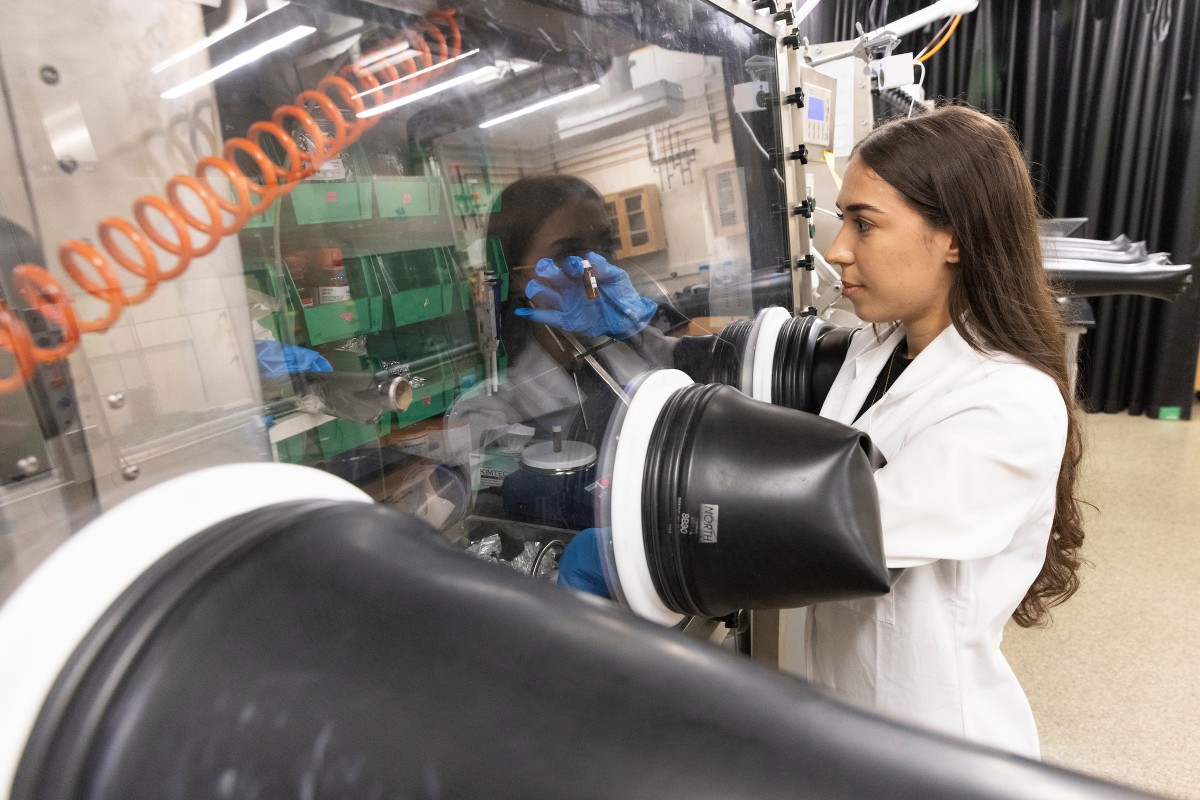Lab and field: Summer is a time for student research

The black gloves that give the “glove box” its name resemble an audience of reaching hands, filled with nitrogen. Physics major Catherine Lahood placed her fingers into the holes and then pushed through into the oxygen-free space, where she began to set up a solar cell experiment.
Many solar-cell and battery technologies rely on substances that react poorly to oxygen or water, making the unearthly atmosphere of the glove box a crucial component to research. Later, Lahood planned a trip to the Analytical and Diagnostics Laboratory (ADL) for the next component of her solar cell research.
A rising senior at St. John’s University, Lahood came to Binghamton this summer as part of the National Science Foundation Research Experience for Undergraduates (REU) program in renewable energy generation and storage. She joins a cohort of approximately 40 students in four different programs — two different streams in the Summer Research Immersion program and another REU in biofilms — participating in 10-week research opportunities this summer at Binghamton University.
Most are Binghamton students, looking to broaden their experience in the lab and field. Others, in the REU programs, hail from smaller colleges and universities that lack the amenities of a large research university.
“The labs are a lot bigger and I wouldn’t have been able to do research like this at my school. Some of these microscopes are millions of dollars,” reflected Lahood, who is researching the stability of new solar cell materials under Associate Professor of Physics Jeffrey Mativetsky, the director of the Materials Science and Engineering program and the renewable energy REU.
MacKenzie Bennett, a senior biochemistry major from Marywood University, and Eduardo Almes, a junior biology major from SUNY New Paltz, worked together on an experiment involving oxidative stress for the biofilms REU, headed by Research Assistant Professor Caitlin Light and Professor of Biological Sciences Karin Sauer. Nearby, Kylie Purkeypile, a sophomore pre-nursing major at the University of Nebraska, was looking at the impact of particular treatments on biofilm dispersion.
Bacterial biofilms are a significant issue in both healthcare and industry, ranging from infections and non-healing wounds to the plaque on your teeth, and it’s not always easy to treat. Not only will the students’ research expand their academic horizons, but it can potentially have real-life impact, too, in helping to develop future treatments.
“Chronic infections are a big issue in today’s society, especially with the rise of antibiotic resistant bacteria,” Purkeypile said.
From caterpillars to chemistry
Katelyn Woo reached toward the witch hazel leaf, gently inspecting it for a hidden visitor. Her sought-after prize: caterpillars, which she would bring back to the lab to conduct research on their thermal tolerance.
A biochemistry major, the rising sophomore is more familiar with the lab than the field — or, in this case, the woods. But that’s also the reason she chose the Summer Research Immersion Program’s Ecological Genetics stream
“I’ve never done fieldwork before this class and I wanted to try it,” explained Woo, during a trip to the Binghamton University Nature Preserve.
While one research team is thermal-testing caterpillars, the other is investigating leaf shelters created by a variety of insect species, including spiders and grasshoppers, explained rising sophomore Justin Yang, a biology major. In particular, they are looking at changes over time, due to such factors as temperature and humidity, added classmate Sam Ramos, a biology major and rising senior.
“It’s like the U.S. Census, but for bugs,” explained Research Assistant Professor of Ecological Genetics Christina Baer.
She turned over leaves in a stand of witch hazel and found a pointed structure resembling a witch’s hat that houses aphids, while a caterpillar created a nearby leaf-roll and a small white dot sheltered spider eggs.
Fieldwork is a key component to the course, both at the Nature Preserve and Broome County’s Aqua-Terra Wilderness Area. Almost all enjoy it — except for the beginning of the summer course, “when we got rained on a lot,” Ramos admitted with a smile. They also spend time in the lab, conducting DNA sequencing of insects and experiments, such as thermal-testing caterpillars. It’s a good balance, observed Yang.
Inside Research Assistant Professor of Chemistry Yiliang (Yancy) Luan’s lab in Science II, students in the Summer Research Immersion program’s Clean Energy Stream tended to their tasks in the final weeks leading up to an Aug. 5 poster session. The stream’s focus is exactly what the name implies: finding new sources of power with a lower carbon footprint than traditional energy sources, such as oil or goal.
One team was focused on creating a fuel cell.
“This one is powered by methanol, which breaks down into water and a little carbon dioxide. That’s better than traditional fuels,” explained rising senior Yoora Cho, a chemistry major.
In ultraviolet light, the vial of perovskite glowed an unearthly greenish gold. Rising sophomore Stephen Lee’s team is exploring new ways to make perovskite quantum dots, a substance in nanoscale that could potentially find applications as light-emitting diodes (LED) and more. It’s a bit of a departure for the neuroscience major, he admitted.
“I wanted to do research into a different field, to see if it’s research itself that really interests me,” he said.
Spoiler alert: It was.
“It’s hands-on and you learning something new. Here, we don’t have to get a specific set of results because we’ve never done (this experiment) before,” he said.

